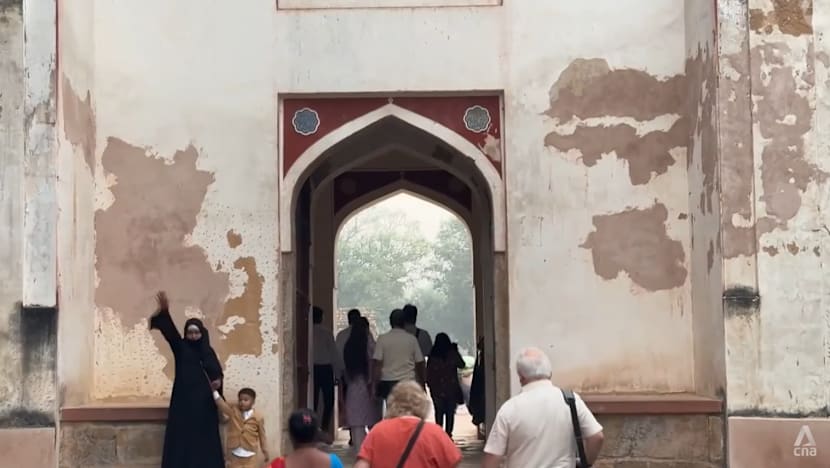India's ancient monuments crumble under the weight of severe pollution, climate change
The Indian government has said that over the long term, its climate policies will help prevent further damage to heritage sites such as the Taj Mahal.

Visible damage from pollution on the facade of the Red Fort historic monument in New Delhi, India.

This audio is generated by an AI tool.
NEW DELHI: Damage to the historic Red Fort in India’s capital city is impossible to ignore.
Run a hand across its centuries-old walls and soot comes away easily – residue from decades of pollution from vehicle emissions, construction and factories.
These deposits could permanently compromise the Mughal-era monument if urgent action is not taken, say researchers.
It is just one example of the new, critical threat faced by Indian monuments which have stood for centuries as testaments to the country’s rich history.
From erratic weather patterns to severe air pollution, climate change is eroding the very foundations of the Red Fort and other heritage sites.
In Rajasthan, part of the 12th-century Sonar Fort in Jaisalmer collapsed in August last year after being battered by unusually heavy rains. The fort, a UNESCO World Heritage site, suffered from a lack of maintenance.
Pollution and acid rain have also caused visible discolouration to India’s most iconic monument – the Taj Mahal.
BUILDING RESILIENCE
Humayan’s Tomb in New Delhi, also a UNESCO World Heritage site, is under threat from unpredictable rainstorms, air pollution and slow upkeep after standing for 500 years.
Polluted water seeping into the structure threatens to weaken it from within.
“It’s almost like our skin – the skin is porous. (If) you put cling film around it, the cells start dying out,” said Ratish Nanda, CEO of the Aga Khan Trust for Culture in India, an organisation involved in cultural revitalisation and heritage conservation.
“Buildings which are generally meant to breathe with water – (their) pores are being closed. The water is being retained in the sandstone or in the masonry. It’s a cocktail of reactions that are difficult to predict,” he added.
Humayun's Tomb is one of more than 70 historic sites in central Delhi that the organisation is conserving.
The effort has drawn on specialist craftsmen from Uzbekistan to painstakingly revive traditional techniques and lost details – a “labour of love etched in rock”, as described by Nanda.
Beyond restoration, conservationists are also building resilience into the landscape.
Thousands of trees have been planted to reduce local pollution, while drainage systems are being redesigned to handle increasingly intense monsoons and manage the risk of waterlogging.
“(The) water disposal system, the roofs, need to be much more secure – much more in a state of alert all the time,” noted Nanda.
INDIA’S CLIMATE POLICIES
The Indian government has said that over the long term, its climate policies will help prevent further damage to these monuments.
Officials say half of India's electricity now comes from renewable sources, and the world’s most populous nation aims to be carbon-neutral by 2070.
In the meantime, early warning systems have been installed at many sites.
Vimlendu Jha, founder and executive director of environmental non-governmental organisation Swechha, noted that most monuments now have a weather station that signals extreme rainfall or high winds.
“But warning alone is not enough, as a warning doesn't do anything more than inform you,” he added. “There needs to be adequate resources and funding for conservation and protection of these places.”
This year, India’s main conservation body, the Archaeological Survey of India, received a 13 per cent budget increase, bringing its funding to US$138 million.
But some experts argue this is still not sufficient. They have instead called for comprehensive risk assessments, regular inspections, and more funding for protective chemical treatments to keep these national treasures intact.
Without sustained investment, they warn, India could lose irreplaceable pieces of its cultural identity – one crumbling stone at a time.


















